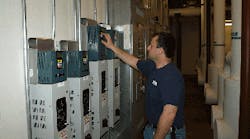Latest from Home
Sponsored
WATERTOWN, MASS. — New England mechanical contractor J.C. Cannistraro has found that the energy auditing and retrofit market, which the firm entered about a year and a half ago, to be profitable and promising. Cannistraro began energy auditing work as a way to differentiate itself, said Bill Fleming, HVAC service manager.
“It’s another tool in the toolbox to help a client achieve results — cost savings and comfort,” Fleming said.
Cannistraro is a member of the Mechanical Service Contractors Association, which has preached the benefits of energy auditing work for service contractors. The work is a straightforward extension of what mechanical contractors are already doing.
“It’s not difficult,” Fleming said. “It’s just different.”
Fleming also noted that giants who finance projects involving the building envelope and electrical systems, in addition to the mechanical work, are doing a lot of the energy service work. Contractors like Cannistraro, on the other hand that specialize in mechanical systems, occupy a better niche.
“We’re focused more on the environment in the building,” Fleming pointed out. “I think it’s a plus. It allows us to specialize. We know buildings and an ESCO doesn’t necessarily know that stuff. We do. It helps us find our sweet spot.”
Better yet, the projects that a mechanical contractor can perform may typically be $125,000 or less and the building owner can often pay for them out of his cash flow. Some of the projects last a week and some last three to four months. If a project requires multiple trades, such as electricians and a controls subcontractor, Cannistraro will manage that. The contractor also works with the client to find all available rebates.
47-year history
In 1963, John Cannistraro Sr. founded J.C. Cannistraro Inc. as a one-man plumbing shop just outside of Boston. With $1,500 and the support of his wife Rita, Cannistraro began installing plumbing systems for MassPort at Boston’s Logan Airport. More than 45 years later, Cannistraro, now chairman, has expanded his company to provide HVAC, fire protection and facilities maintenance services for large mechanical plants at hospitals, universities, laboratories, and many other facilities.
Now in its second generation of family ownership, the company is operated by four of Cannistraro’s eight children. Under current President John Cannistraro Jr., the company has invested in BIM and pre-fabrication technologies in order to continue to improve quality and efficiency on every project.
Through the years, the company has incorporated non-family management in many critical business segments including estimating, scheduling, human resources, marketing, purchasing, and safety. Using the talent and expertise of its workforce, Cannistraro designs and builds mechanical systems for projects of all sizes and scopes. Today, Cannistraro has a workforce of more than 300 men and women and earns annual revenues of more than $120 million. The company is known throughout the industry as a leader in construction technology and pre-fabrication.
The Plumbing Museum
Cannistraro also maintains the Plumbing Museum in a 150-year-old icehouse that the contractor renovated in 2008. The Plumbing Museum has been run by the family of Russell Manoog, of Manoog Supply in Worcester, Mass., since the 1970s. As Manoog neared retirement, however, he needed a reliable curator for the extensive collection of tools, materials and fixtures from various periods, including the early 18th century, Victorian period, the early 20th century and contemporary times.
Cannistraro’s Plumbing Museum also contains full examples of the structure of a “typical” modern-day plumbing system, such as exposed piping of a home. The museum features an historic lavatory bowl whose only other example is at President Thomas Jefferson's Monticello home, antique plumbing tools and fittings, copper tubs, and wooden water pipes that had served as Boston water mains.
Uses software tool
After Cannistraro entered the auditing market, a company committee selected a software tool called BuildingAdvice that was created by a company named AirAdvice. Fleming said the adaptability of the tool allows his people to generate statistics that show a client how much energy and money he can save.
“It’s a sales tool,” said Fleming, noting that, unlike an ESCO, Cannistraro wants a long-term relationship with a building owner. “It’s about what we can do for an existing client. We can do an onsite audit once a year as part of a maintenance agreement. As the sales people can attest to, this gets our foot in the door. We can benchmark the building as long as they can provide 12 months of utility bills. Then we can come in and do preventive maintenance. It helps build a trusting relationship — ‘We’re trying to help you save some money.’
“The key is to get with the right person to talk to in order to get the energy bills,” Fleming continued, “and once you do that, you can get the conversation started. Unless you have P&L responsibility for the building — some facilities guys have it and some don’t — if you get to the guy who is responsible for cost saving for the building, then can prove to him you can save on energy costs.”
Long-time client
Longtime client Metro Realty Trust was “fairly receptive to the energy conversation,” said Fleming. A medical laboratory tenant occupying 20,000-sq.ft. of a 55,000-sq.ft building was considering a move, partially due to its unavoidably high power usage and the costs associated. Metro Realty Trust knew that if it could lower the building’s energy costs, it would have a leg up on keeping the tenant.
Metro Realty Trust and Cannistraro saw eye to eye: improving the building’s performance would be good for the building’s profitability. Cannistraro did a free energy benchmark and formulated multiple-tenant utility information into a spreadsheet. Fleming showed Metro Realty Trust the damage: a DOE Energy Star score in the 30s (on a scale of 0 to 100, 100 is the most efficient).
“Transitioning the client from a benchmark to an audit is the hardest part of the process,” said Fleming. “It all depends on the effectiveness of our presentation. How we present what we do is a key part of the process.”
By transferring the information into a separate template, Fleming presented a customized report in a format that worked for the client.
Based on the energy audit, Cannistraro proposed nearly $100,000 in retrofit and maintenance work for Metro Realty Trust.
In a few months, Metro Realty Trust had come up with the funds to complete the project.
Right now, Fleming has two more audits pending — one for a hotel, the other for an office complex — and recently completed work that qualified for $8,700 in state rebates. Fleming estimates the client will save $15,000 per year in energy usage.
Robert P. Mader
Bob Mader is the Editorial Director for Penton's mechanical systems brands, including CONTRACTOR magazine, Contracting Business and HPAC Engineering, all of which are part of Penton’s Energy and Buildings Group. He has been with CONTRACTOR since 1984 and with Penton since 2001. His passions are helping contractors improve their businesses, saving energy and the issue of safeguarding our drinking water. He is a graduate of the University of Notre Dame with an A.B. in American Studies with a Communications Concentration.


